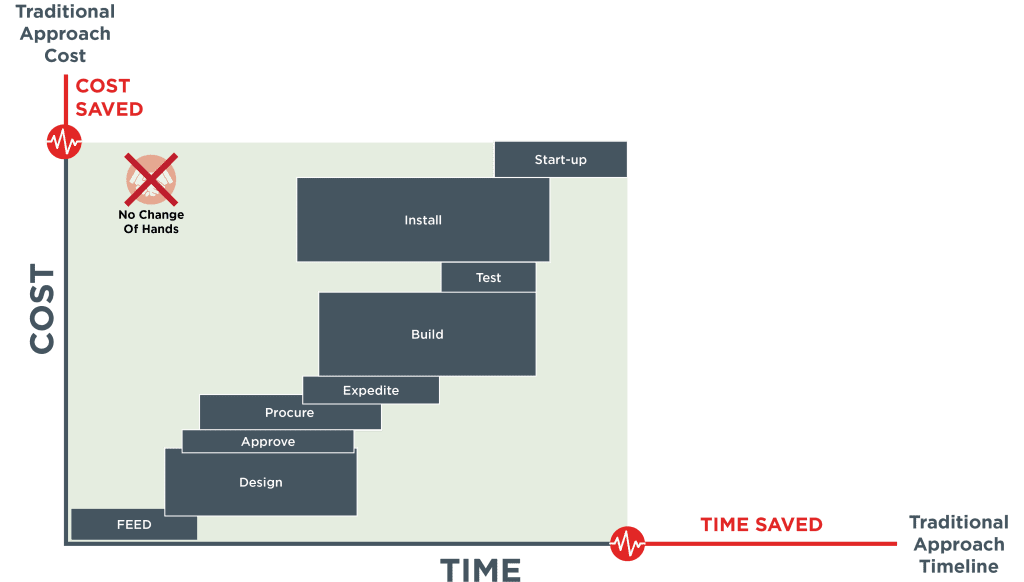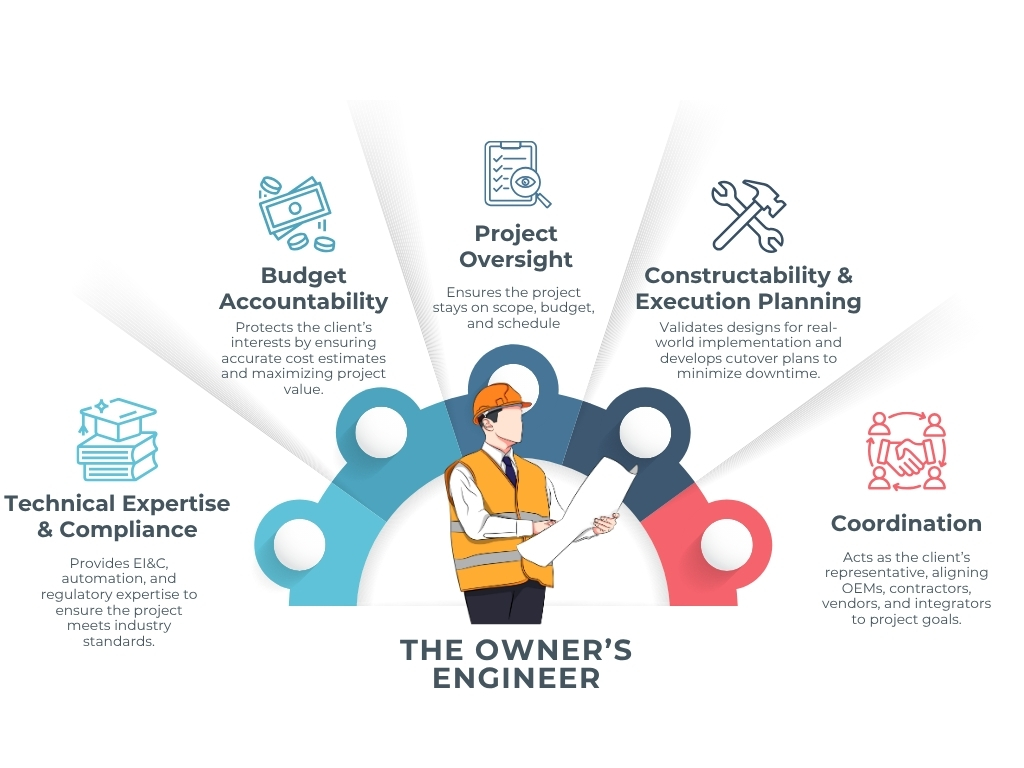Whether updating legacy systems or expanding with new operations, Revere’s FEED Plus approach ensures continuity in your controls upgrade from planning through execution. It eliminates costly surprises and reduces your risk.
A Front-End Engineering and Design (FEED) study is the critical early planning phase, especially for complex systems integration projects where networks and controls must connect multiple machines, processors, and vendors. It thoroughly examines, defines, and documents all aspects of the project to ensure clear specifications and expectations from the start, preventing costly surprises and delays during execution. Through in-depth discussions, a FEED study establishes well-defined project guidelines, timelines, technical documents, applicable standards, scope, and stakeholder roles to ensure coordination.
Questions to Ask Yourself When Deciding “Do I Need a FEED Study?”
- Am I worried about scope creep, budgeting uncertainties, or timeline overruns?
- Am I planning an upgrade but missing important data or insights from stakeholders?
- Does my facility’s P&ID accurately reflect your current operations?
- Do I have the internal resources and expertise needed to define a clear project scope?
- Am I certain that there are no scope gaps between project participants?
- Do I want confidence in selecting the right partner and approach before committing to a full project?
The Value of a Control System Engineer’s Input in Early Design
Control system engineers play an important role in ensuring your project’s success by addressing high-value design considerations early in the process. Unfortunately, many large projects lack adequate input from experienced control system professionals during the front-end phase, leading to misaligned specifications, unforeseen challenges, and expensive reworks down the line.
By engaging control system engineers early, you benefit from their ability to:
- Ask the right technical questions, such as preferred I/O platforms, visualization requirements, and redundancy needs.
- Ensure real-world considerations like available space, environmental factors, and system integration are addressed upfront.
- Highlight cascading impacts of design decisions, ensuring specifications align with operational and technical goals.
Why It Matters:
When control system engineers are involved from the start, they identify limitations and considerations you may not have anticipated. These insights drive smarter decision-making and avoid costly redesigns. Their expertise ensures your system is not only functional but optimized for long-term performance and scalability. Control systems are often the last thing between your investment and your ROI.

Key Outcomes of a FEED Study:
Ensure Accurate Bids and a More Precise RFQ:A detailed FEED study ensures vendors can provide comparable bids, minimizing ambiguity. With clear documentation and specifications, your RFQ is more precise, allowing for true “apples-to-apples” bid comparisons and better cost control.
Prevent Scope Creep:
A FEED study eliminates uncertainty by defining exactly what the project requires upfront. Well-defined deliverables and timelines ensure clarity, reducing the risk of unexpected changes and costly surprises during execution.Prevent Costly Reworks:
Involving an EI&C expert from the start ensures that high-impact design considerations are factored in early, rather than treated as an afterthought. This reduces the risk of having to make expensive changes later to accommodate control system needs.Facilitate Collaboration:
By involving integrators early, your team benefits from expertise that ensures operational alignment.Enhance Safety Standards:
Proactive hazard reviews during the FEED phase identify risks early, streamlining compliance efforts and it also reduces cost as compared to trying to add safety in later.Get an Accurate Current-State Representation of Your P&ID:
A FEED study ensures your P&ID (piping and instrumentation diagram) reflects current site conditions, providing a clear foundation for planning upgrades or expansions.Reduce the Risk of Escalating Costs:
Clear specifications help mitigate risks by aligning budgets and deliverables before execution begins.
Revere’s Method: Introducing FEED Plus
While traditional FEED studies lay the groundwork for a project, Revere identified several gaps in the traditional FEED study process that often left projects vulnerable to inefficiencies, miscommunications, and cost overruns. These gaps included incomplete scoping, ambiguous language, and a lack of attention to constructability and execution. In response, Revere developed FEED Plus to go beyond the basics, addressing these challenges head-on.
| Standard FEED Study | Revere’s FEED Plus | |
| Scope Definition | Focuses on the “what” of the project with limited details. | Goes beyond the “what” to also define the “how”, offering actionable strategies for execution. |
| Risk Mitigation | Relies on vague terms like “as required,” leaving room for ambiguity and risk. | Replaces ambiguity with specifics, mitigating risks and avoiding unexpected costs. |
| Constructability | Often overlooks practical construction challenges, leading to delays and rework during installation. | Addresses on-site challenges like panel locations, cable routing, and equipment placement upfront. |
| Documentation Accuracy | Relies on existing documentation, which may be outdated or incomplete. | Conducts a full site audit with updated P&IDs, as-found drawings, and a comprehensive drawing index. |
| Stakeholder Involvement | Limited stakeholder input; lacks alignment on project goals and expectations. | Engages all stakeholders to align on definitions of success and create tailored solutions. |
| Expertise | Primarily engineering-focused; lacks hands-on insights into construction and integration. | Combines engineering expertise with real-world construction and field experience for practical solutions. |
| Testing | Limited or undefined testing plans, leading to potential issues during commissioning. | Develops a thorough testing plan, including Factory Acceptance Testing (FAT) to ensure smooth implementation |
| Budget Confidence | Provides approximate budgets with built-in contingencies to account for unknowns. | Offers highly accurate, appropriation-ready budgets based on detailed analysis and constructability insights. |
| Deliverables | General deliverables without step-by-step implementation guidance. | Includes cutover plans, realistic schedules, and actionable strategies tailored to your project. |
| Accountability | Ends at scope delivery, leaving clients to coordinate the project execution. | Revere stands by its scope and budget, taking full accountability for execution and cost alignment. |
What Puts the “Plus” in FEED Plus?
With Revere, the value of a FEED Plus study doesn’t stop when the planning phase is complete. Unlike other providers that deliver a scope and leave you to find a separate partner for implementation, Revere is uniquely positioned to execute the plan they’ve created. From design to installation and integration, Revere takes full responsibility for seeing your project through to completion.
This transition from planning to execution also acts as a form of insurance for your project’s success. The same team that scopes and budgets your project during the FEED Plus study is responsible for delivering it, which means the quantity-based proposal Revere provides is the price they honor. If unforeseen issues arise during implementation, Revere takes responsibility—not the client. This accountability ensures that your project stays on budget and on track, giving you peace of mind and confidence in the outcome.

FEED Plus Deliverables
- Control architecture and network design
- Delegation of responsibilities (DOR)
- P&ID validation and process flow diagrams
- IT/OT integration and MES workflow
- OEM integration requirements
- Programming standards
- Drawing index
- I/O and intelligent device list
- Motor index validation
- Balance of plant electrical list
- Control panel layouts and installation plans
- Panel schematic requirements
- Installation engineering typical drawings
- Project timeline and execution schedule
- Check-out and commissioning methodology
- Fixed-price proposal (+/-10%)
What Sets Revere Apart?
Practical Expertise: Our staff all have real-world experience in electrical installation and control systems which ensures that they produce practical, actionable designs. Other FEED studies are often performed by people who have never actually executed that kind of work.
Customer Focus: Our non-transactional approach builds trust and true collaboration. A FEED Plus study is our first deep dive into your business where we start to become a part of your team, representing your best interests from then on.
End-to-End Capability: From initial scoping to full execution, Revere’s comprehensive services reduce risk and provide accountability.
Vertically Integrated Project Delivery: Revere serves as a single point of accountability, with in-house resources to deliver every element of the EI&C scope, ensuring seamless execution with fewer handoffs and reduced risk.


Why It Matters:
- Accountability: Revere’s dual role as planner and implementer ensures that the scope and budget we propose are realistic and actionable. If we miss something in scoping, we take responsibility for it.
- Risk Reduction: By integrating constructability and real-world execution insights into FEED Plus, we significantly reduce the risk of surprises during implementation.
- Seamless Transition to Execution: With Revere, the team that scopes your project has the expertise to actually execute it, ensuring continuity and fewer errors.
- Added Insurance: FEED Plus provides peace of mind knowing that the price quoted during scoping is the price we commit to delivering.
The Role of the Owner’s Engineer in FEED Plus
In many modern facilities, the loss of in-house technical expertise due to retirements or cost-cutting has left project teams without the resources needed to fully scope and oversee complex projects from a project management and subject matter expert perspective. This makes the role of an Owner’s Engineer critical. Revere steps in to fill this gap, providing each project with a dedicated engineer with the technical oversight and project management experience to advocate for the projects’ success.
An Owner’s Engineer acts as an advocate for the client, ensuring that the project’s goals are consistently prioritized throughout planning and execution. This role bridges the gap between multiple stakeholders, including vendors, contractors, and internal teams, ensuring alignment and reducing risks.

Why It Matters:
- Client Advocacy: The Owner’s Engineer ensures the client’s best interests are represented at every stage, from initial scoping to execution.
- Technical Oversight: They bring a deep understanding of EI&C systems, helping to identify and mitigate risks early.
- Consistency Across Stakeholders: Acting as a single point of accountability, the Owner’s Engineer coordinates between teams to avoid miscommunication and inefficiencies.
- Constructability Assurance: By addressing real-world implementation challenges upfront, they ensure the project design is practical and achievable.
Case Study: Melt Shop Modernization FEED Study

Problem
- Incomplete engineering documentation, making it difficult to define scope.
- Complex stakeholder coordination, involving multiple vendors and contractors.
- IT/OT integration concerns, requiring structured data workflows.
- Constructability risks, including panel placement and cabling layouts.
- Uncontrolled costs, due to undefined vendor integration and unclear responsibilities.
Solution
Revere’s FEED Plus study provided a structured, three-phase approach:
- Engineering documentation review to correct inconsistencies in P&IDs and motor lists.
- Delegation of responsibilities (DOR) to align OEMs, contractors, and the client team.
- Control architecture and network design to define system performance requirements.
- HAZOP risk assessment to identify and mitigate operational risks.
- Constructability planning to optimize panel placement and electrical layouts.
- Fixed-price proposal (+/-10%) to provide cost certainty and a clear execution roadmap.
Outcome
- Minimized downtime risks with detailed integration planning.
- Seamless IT/OT data flow for MES integration and batch tracking.
- Tighter cost control by eliminating scope ambiguity and pricing risks.
- Stakeholder alignment through clear DOR assignments.
- Execution-ready plan, enabling confident implementation.
By conducting a FEED Plus study, the manufacturer gained a detailed, execution-ready roadmap that reduced scope gaps, improved integration clarity, and provided cost certainty before implementation. The result was the groundwork for a modernized, fully optimized melt shop that minimized risk while setting the client up for long-term operational efficiency.
FAQ
Why should I spend money on a FEED/FEED Plus study upfront?
A FEED study is an investment that saves money in the long run by minimizing risks, avoiding costly rework, and ensuring your project stays on budget and schedule. With Revere’s FEED Plus, you’re also getting actionable insights and a detailed roadmap for easy implementation.What if my project doesn’t move forward immediately after the FEED Plus study?
The work completed in a FEED Plus study is never wasted. It provides documentation and insights that can be revisited when the project is ready to proceed—even if that’s years later. Additionally, this planning prevents unnecessary expenses and scope creep when the time comes to execute.Can’t my in-house team handle project scoping?
While your team may have expertise, most internal teams lack the dedicated time or resources to focus solely on a comprehensive FEED study. Revere’s experts bring decades of experience in engineering, construction, and integration, ensuring nothing is overlooked.How long does a FEED Plus take?
A FEED Plus study typically takes about three weeks, depending on the project size and complexity. Revere’s structured process ensures this timeline includes thorough site audits, stakeholder input, and deliverable preparation.How does FEED Plus help avoid scope creep?
Revere’s FEED Plus uses detailed scoping, updated documentation, and stakeholder alignment to minimize ambiguity. With less than a 0.5% scope creep rate historically, Revere ensures your project stays on track and within budget.What kind of projects benefit most from FEED Plus?
FEED Plus is ideal for complex, high-risk projects where precise planning is needed. This includes modernization efforts, legacy system upgrades, plant expansions, and greenfield installations. It’s especially valuable where the scope is unclear, documentation is outdated, or constructability issues need resolution. It’s particularly useful for projects requiring tight schedules or minimal downtime.Can Revere work with my existing vendors or systems?
Yes, Revere is partner-agnostic and works with a wide range of platforms, vendors, and systems. Their priority is finding the best solution for your needs, not promoting specific products.Can Revere execute the project after completing the FEED Study?
Yes. Revere’s expertise spans the entire project lifecycle. Our team can carry out the work defined in the FEED Plus study, ensuring continuity and fewer errors. This makes the process more efficient and provides peace of mind knowing the scope and budget will be honored.

